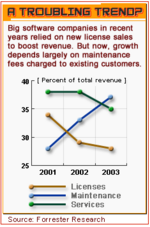Whether you know it or not, this seems to be the way that alot of early stage companies make strategic and tactical decisions. People run around the halls and manage by crisis, moving from one deal or issue to the next without any overarching goals and process in place. Solving this not only requires better planning but also staying disciplined, holding you and your team accountable, and executing on those goals. Trust me, this is top of mind for me as this is the time of year that many companies start formulating their plans and goals for 2005. We have all been through a number of these so-called planning sessions and have come out with great plans and ideas, but the problem most of the time is that the execution of it never happens. Hopefully, some of my thoughts and suggestions below will help you simplify this process and create a framework to measure, manage, and execute.
So let me first start with accountability. Without accountability, it is hard to manage a business. What I typically like to see is a management team put together a few simple company goals, say 3-5, which are easy to remember and that can be measured by Yes/No answers. If you have too many goals or if you cannot measure them, then you cannot manage them. With simple Yes/No goals there should never be any ambiguity about completion. Those goals are usually then rolled out by department (3-5 goals that help the company realize its overall goals) so that marketing, sales, and engineering can be in synch with the company goals and so they can be easily monitored and measured by the executive team and board. Obviously you must be flexible and make course corrections through the quarter and year, but this process helps the executives all get on the same page and drive the company in the right direction. If you don’t have knock down, drag out fights over the company goals and the appropriate allocation of resources to realize them, then you are probably not challenging each other enough. Once the goals are set and agreed on, you must communicate and share them with the whole company.
By way of example, an overall goal could be to ship version 4.0. It is a pretty simple Yes or No proposition. Obviously when you roll it down to marketing and development, each department will have its own priorities to make the shipment of version 4.0 a reality. Whenever a new issue or opportunity arises your team can always ask themselves whether or not doing X can help them realize the goal. If not, then it is probably not worth doing. Yes, you have to be flexible throughout, but having a guiding light or north star to rely on can help you better manage your people and help your people better manage themselves. As you can see, when it comes time to running the business on a day to day basis, these goals can be quite helpful in moving your company from a Ready-Fire-Aim business to a Ready-Aim-Fire one. Remember, being an entrepreneurial company means by definition you have limited resources and need to allocate them appropriately to get the best bang for the buck.
Obviously it is quite difficult to cover the above topics in such a brief post, but I hope to dig deeper into the strategic plan and budgeting conversation in future posts. Maybe you can even suggest some other areas of interest for you?
